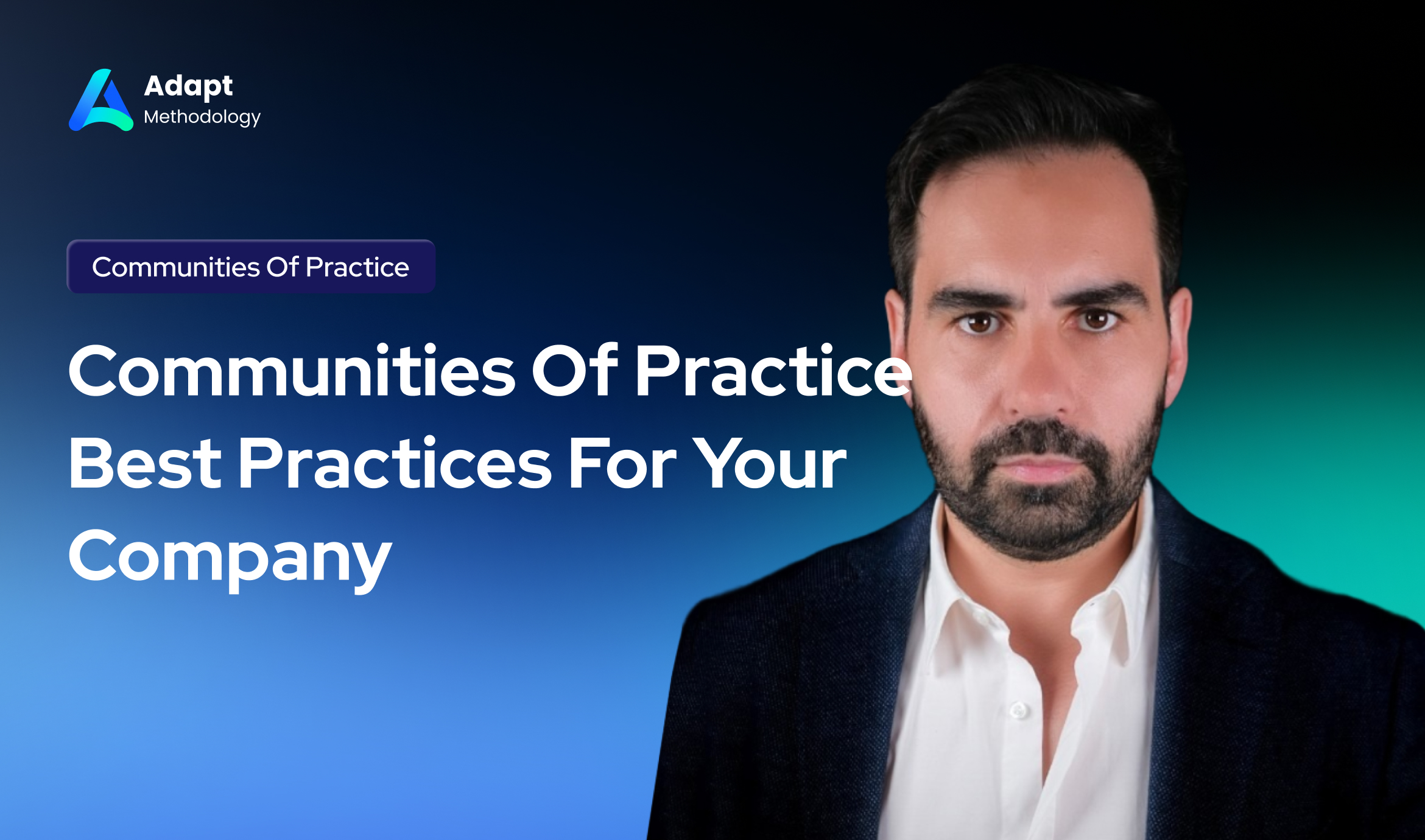Share this
Communities Of Practice Best Practices For Your Company
by Luis Gonçalves on Jan 13, 2024 5:49:30 AM

In the quest for a successful project to product transformation, harnessing the collective wisdom and shared learning within your organization can be a game-changer, that´s why your "Communities Of Practice Best Practices" come in, offering a platform for individuals with shared interests or professions to collaborate, innovate, and learn together.
However, to truly reap the benefits of these communities, it's crucial to understand and implement best practices.
Today's blog post focuses on "10 Communities of Practice Best Practices," a guide to leveraging these dynamic groups effectively in the context of a project to product transformation.
Communities of Practice, when effectively managed, can become powerful drivers of knowledge exchange, problem-solving, and innovation.
They can contribute significantly to project to product transformations by improving decision-making, fostering creativity, and creating a culture of continuous learning. However, like any other organisational tool, the effectiveness of these communities is determined by how they are nurtured and guided.
Whether you're a seasoned project manager, a team leader overseeing a transformation, or a member of a Community of Practice, understanding these best practices can help enhance the effectiveness of your group, thereby boosting the success of your transformation efforts.
This post will explore these practices in depth, providing you with actionable insights for optimizing your own Communities of Practice.
Let's delve into these best practices and understand how they can amplify your project to product transformation journey.
ADAPT Methodology® is a unique Digital Product Development framework to change traditional project-centric companies toward product-led companies!
Society changed and leaders need support in the way they lead and design their digital product organizations, that is the reason why the ADAPT Methodology® was created, but now let’s get a deep dive into Communities Of Practice if you want to get a deeper knowledge about this topic.
10 Communities Of Practice Best Practices
Communities of Practice has been an efficient way of leveraging businesses over the past decades, but we think it's not enough for your company to become a great Digital Product Company.
Communities of Practice should be able to provide an opportunity for your team to build their expertise and deepen their knowledge in your industry.
Ideally, this is achieved through regular collaboration within an environment where everyone is eager to share his or her knowledge with one another.
However, in its early stages, initiating and encouraging your team to make CoPs work can be a bit challenging. This can frustrate you but using the ten best practices below can address this slump head-on.
-
Establish a clear plan or “structure”
This will allow everyone to have an idea of how the Communities of Practice will function and the various expectations of each member.
You can do this by creating a “charter” or a sort of rules of engagement where you identify the group’s strategy, communication techniques, and scheduling and holding meetings. However, remember, this “structure” should not alienate the “informal” nature of CoPs.
CoPs foundation is deeply rooted in its “social” nature. Don’t suffocate your people with rules in CoPs.
-
Arrange a member's introductory meeting
Whether the meeting is online or offline, members should be able to meet one another and start discussing their goals and objectives.
This activity will also give them the chance to gain more confidence in sharing ideas and knowledge with the other members. This will help in enhancing the effectiveness of the Communities of Practice in the long run. It’s a social learning community.
-
Make sure to hold meetings on a regular basis
Holding meetings on a regular basis is undoubtedly another key for Communities of Practice to achieve success. These meetings are perfect opportunities for members’ collaboration and sharing.
Members can also enjoy the following: the opportunity to share knowledge, the ability to strengthen communication, a more effective way to interact, the chance to speak directly with other practitioners, and the ability to receive immediate input and feedback.
What you can do from the management side is to make it sure that you give your team the time for these regular meetings. Also, make sure that there would be less friction and stress in providing this schedule to protect the momentum of your CoPs.
-
Software tools used in project management can become the community’s virtual headquarters
Some examples of these tools are Basecamp, Asana, Trello, and Facebook’s Workplace.
By using these platforms, members can share documents, delegate tasks, keep track of the project’s deadline, keep themselves updated with a community calendar, and most importantly extend the conversation.
As a result, the community is well organized and can stay on-task which remains true even when some members are participating remotely.
-
Survey your employees to define actual problems
This company-wide survey of employees allows the organization to learn about the issues or weaknesses that should be focused on by the Communities of Practice.
Members can focus on the organization’s most pressing issues and allocate time and resources to tackle these concerns during their regular meetings. The survey spells out the problem for the CoPs.
It is an indirect way to spark a conversation around it without pushing the interest of your company blatantly. Again, we don’t want to alienate the social learning nature of CoPs.
-
Identify a clear objective or purpose
Get a clear idea of the following: the purpose of creating the community; how to fine-tune the community’s training strategy; and ways to improve the CoPs.
As a result, members will have a good understanding of how to do their part to reach the desired results in relation to the established objective and purpose of their CoPs.
-
Stay conscious of the knowledge and experience that each member offers in the community
Be able to determine what each member of the community brings to the table and what core experience or knowledge they can share with the others.
Ideally, the community must be made up of a diverse group of members wherein each one offers something invaluable and unique to the group. You would want to have a group that represents a wide range of employees, expertise, and interests.
This can be particularly useful if you’re building a company-wide learning community. You can identify at least one member to represent a specific department. You can also find those who excel in certain areas or skill sets.
-
There should be an appointed moderator
Having a moderator is vital to the success of the community. Find and appoint someone who is not only knowledgeable on various topics but is also widely appreciated.
Some of the tasks of a moderator include: keeping the group on-task; providing guidance during meetings; and being a liaison between the community and the organization.
The appointment can either be made directly or by conducting a group vote wherein each member would vote for the person who they believe is the community’s best representative.
-
Always keep in touch through online forums and social media
Communities meet both in-person and online. It is essential that members have various means to share ideas and work together. Using these online platforms can be a convenient and fast way for members to arrive at new and innovative solutions.
These include social media sites such as Twitter, LinkedIn, and Facebook. Through these platforms, members can easily share files, videos, and images.
The thing is, they should opt for this medium of communication and should not see it as an invasion of their social media use.
-
Offer resources and support to other communities
Communities thrive on the support and resources that are offered by their leaders (You). These can include tools, apps, and sometimes monetary funds.
This kind of support is particularly useful in the beginning stages of the group. Communities Of Practice Best Practices must include training, strategies, and development solutions that can benefit your company as a whole.
In conclusion
Achieving these best practices requires bringing together these four main components: the people, the technology, the structure or process, and your mindset.
CoP's core goal is for its member to develop their knowledge through social learning - benefiting your company in terms of innovation, teamwork, and other by-products of CoPs are something that you can indirectly steer using different approaches.
The key to reaping all the rewards of CoPs is to be strategic about interacting with it, have a long-term mindset, and support it so providing value to improve your company will become almost second nature to CoPs.
Did you like this article?
We enable leaders to become highly valued and recognized to make an impact on the World by helping them to design Digital Product Companies that will thrive and nourish in the Digital Age, we do this by applying our own ADAPT Methodology®.
If you are interested in knowing if you have what it takes to design and build a great digital product company simply take our Digital Leadership Influence Scorecard.
If you want to know how we can help you to start your transformation please check out our: Training.
If you are interested in doing a transformation in your company please check out our: Consulting.
Share this
- Agile Methodologies (18)
- Product Strategy (18)
- OKRs (16)
- Scrum (16)
- Product Mindset (14)
- Project To Product (10)
- Agile Retrospectives (9)
- CoPs (9)
- Knowledge Sharing (9)
- Time To Market (8)
- Product Discovery (7)
- Continuous Improvement (5)
- Strategy (5)
- Scrum Master (4)
- Content Marketing Strategy (3)
- Product Owner (3)
- Technical Excellency (3)
- Digital Transformation (2)
- Innovation (2)
- Scaling (2)
- Team Building (2)
- Business Model (1)
- Cost Of Delay (1)
- Customer Feedback (1)
- Customer Journey (1)
- Customer Personas (1)
- Design Thinking (1)
- Digital Leadership (1)
- Digital Product Tools (1)
- Go To Market Strategy (1)
- Google Design Sprint (1)
- Lean Budgeting (1)
- Lean Change Management (1)
- Market Solution Fit (1)
- Organisational Impediments (1)
- Outsourcing (1)
- Product (1)
- Product Metrics (1)
- Product Roadmaps (1)

Organisational Mastery
Get your free copy

ADAPT
Get your free copy

Product First
Get your free copy

